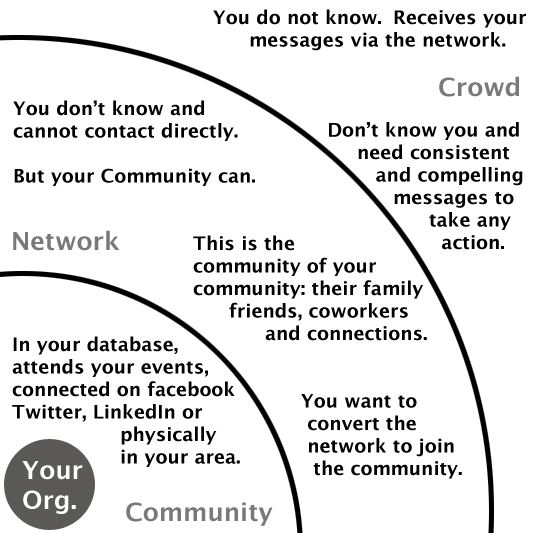Last week I presented for my second time with Nonprofit Webinars. The first time I focused on DIY Community Engagement Metrics and shared lots of templates and examples. This time around, my topic was Crowdsourcing vs Community-Sourcing, answering questions about the difference is and what the opportunities are for organizations looking to get connected outside their organization.
Slides
Notes
Definitions
Let’s start at the beginning. What do all these words even mean? Here are the definitions I use in my work and when talking to groups I work with. Creating specific definitions for these terms which are often used in an overlapping way will help you and your organization ensure you’re all really on the same page.
The Cloud
For me, the two most prominent reason to include crowdsourcing in your engagement strategies for campaigns or contests include:
- Crowdsourcing invites diversity by encouraging anyone with an idea or interest to participate
- Crowdsourcing levels the playing field so it isn’t just your “favorites” or those you already know that get to play
When it isn’t a fit
Sometimes what you want to do and the tools at your disposal just don’t match, though. And sometimes that means crowdsourcing. It isn’t right for every project or process and is often not right for every organization. Here are a few instances when crowdsourcing just isn’t a fit:
- You need things to be very specific or follow tight criteria
- You are working very quickly or flexibly (where communication with the crowd could be difficult or time consuming)
- You already know what you want (be honest – some times organizations know what they want to do or what the product is they want to build, engaging in a crowdsourced process will only frustrate possible supporters when that truth becomes clear)
Community & the Crowd
Ultimately, you should have a plan for each. Communicating with the crowd and the community are very different but can both be really valuable for the success of your campaign or call to action. Setting goals and defining messaging at the start of your process to target each group will help you plan for and engage beyond just those you know.
Elements
The core elements in both crowd and community engagement are time, action, and people. You can uses these breakdowns to help you identify the various options you want to use:
Time
Is it a one-time or sustained engagement? Is it just an event and you do not have the capacity to maintain or support a community around it once the event is over? Recognizing the limits or options within your organizational capacity can really be the biggest determinant for the Time category – what capacity do you have to maintain this?
Action
The action you want people to take – remember, even if your message or campaign doesn’t have a “call your congress person” or “sign this petition” action, you are still asking them to do something – can be passive or active. An active call is more appealing to your community, and less appealing to the crowd, because they already know you, trust you, and have opted-in to supporting your work. Similarly, a passive action isn’t very interesting to your supports considering that they are already taking passive action by following you, signing up for your messages etc. But a passive action can be attractive to the crowd if it is simple and consistent.
People
Who do you need to reach? Is it the crowd, community or a hybrid? It is important to have a plan for each and an understanding of what your messaging is for both segments, but that doesn’t mean every project you do is a hybrid. You may run a campaign or push out a call to action to your community that is targeted and asking a lot. But the message for the crowd comes at the end when you encourage them to share broadly to their networks a short message about your organization or the campaign.
Designing for the Community:
- Customizable – let the community own your message and cause by personalizing their involvement or output
- Consistent/clear/compelling goal – your supporters have joined you because they care about your cause (some times, even if it doesn’t seem like anyone could care any more about it than your organization, they do!) so provide clear and inspiring goals to meet together
- Aggregate and promote – be sure you are pulling together all of the contributions from the community and promoting people in real-time
Designing for the Crowd:
- Shareable – messages, content, and actions that are shareable and don’t necessarily include a link can be picked up and pushed around the network and cloud easily
- Consistent messaging – to ensure that this layer of people who do not know you are able to understand what you do and who you are, your messages need to be consistent
- Compelling story – research continues to show that one of the most important triggers to donations and actions are compelling stories
Case Studies
For the case studies, use the slides above and scroll through. If you aren’t familiar with the organization or campaign, there are links below. This is your learning in practice part! Below I have listed each case study, with a link if you want to check it out. Review the example and see if you can identify the three elements at play: Time, Action, People. I’ve included the answers below.
Connec+ipedia (slide 25) – http://connectipedia.org
Answers: sustained, hybrid, crowd
Ushahidi (slide 26) – http://haiti.ushahidi.com/
Answers: 0ne-time, active, crowd
NetSquared Challenges (slide 27) – http://netsquared.org/projects
Answers: hybrid all around (sorry, it’s the trick question!)
350.org (slide 28) – http://350.org
Answers: sustained, active, crowd
NWF – Be Out There, mother’s network (slide 29) – http://www.nwf.org/Get-Outside
Answers: sustained, active, community
To Mama With Love (slide 30) – http://tomamawithlove.org
Answers: one-time, active, community
—–
What do you think? How have you engaged the crowd or your community in your campaigns, messages or calls to action? Any examples you can share with others?


*raises hand* – What is a “passive action”? A slacktivism thing, like clicking “Like” on Facebook?
Great question, Laura! You are absolutely correct. A passive action just
means, essentially, start following. Opposed to, say, go off the beaten
path.
Great insights, Amy! Your breakdown of the elements of both crowd and community management are very informative.
Having been a part of the 3six5 project, author Victoria Harres pointed out that there 5 key elements of
community management and crowdsourcing:
1. Responsibility
2. Tight deadlines
3. Credit
4. Clear goal
5. Engagement
To know more about her insights, here’s the link, http://crowdsourcing.org/l/1183.
Thanks for this info. It was very helpfull
Thanks for the info!